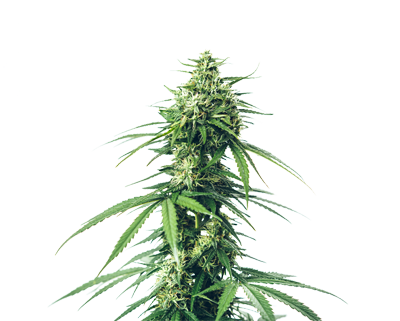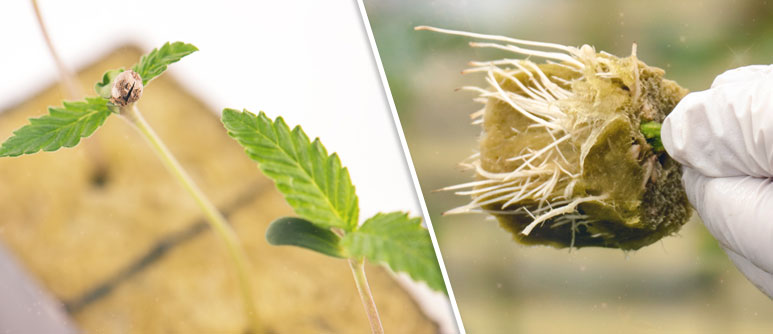All about cannabis seedlings

Learn the essentials about cannabis seedlings together with great tips for optimal seedling growth here in our CannaConnection growing guide.
Most cannabis growers refer to the seedling stage of cannabis plants, when the shoots start to develop their first set of “real” leaves. Compared to the embryonic cotyledons, which have an oval shape, this second set of leaves will already look like cannabis leaves with the typical serrated edge, but it will only be one “finger”.
The next leaves the seedling will be growing will have 3 fingers and the following sets that will develop afterwards will more and more resemble the common cannabis leaf shape until they will have the full set of 5-7 fingers, sometimes more.
DURATION OF THE SEEDLING STAGE OF CANNABIS PLANTS
The number of leaf fingers, that is when the leaves are finally reaching their final number, is also when cannabis growers say that the seedling stage is over and the next growing phase of the cannabis plant, the vegetating stage, is beginning. Other growers consider the seedling stage over when the stem reached a certain thickness or when the plant has grown 3-4 leaf nodes.
The duration of the seedling stage of your cannabis plant can vary depending whether you grow indoors or out. Grown indoors, your plant will normally spend 2-3 weeks being a seedling, while the seedling phase when grown outdoors can last up to 6 weeks.
While your seedling will be growing eagerly to become a fully grown cannabis plant, it will spend a good amount of energy on developing a root system. A healthy root system is important, so that the plant can take in nutrients optimally for healthy growth.
TIPS FOR YOUR CANNABIS SEEDLINGS
If you place a small fan at the location where you grow your seedlings and have a weak, but constant stream of air blowing over them, it will benefit them in several ways. The airflow can help prevent the growth of mould, which young seedlings in particular are prone to. The steady stream of air will also make your seedlings put some extra energy into growing stronger, with a better and more resistant structural integrity.
WHEN TO TRANSPLANT YOUR CANNABIS SEEDLINGS

Be careful, since young seedlings are very fragile and usually don’t take it too well should you transplant them prematurely. The time to transplant the seedlings into bigger pots has come once you see, that the seedling has developed a solid root system. If you grow your seedlings in small starter pots or in rock wool, wait until you see roots coming out the holes or on the sides of the rock wool cubes.
Still, be careful when transplanting and try to avoid damage to the still small and fragile plant. When you grow seedlings in rock wool cubes, this has the advantage that you can leave them in the cubes when transplanting, which helps reduce the risk for any damage.
LIGHT DURING THE SEEDLING STAGE
Seedlings don’t require too much light to grow. In fact, a light, that is too strong, can sometimes do more harm than good in this early stage. Many cultivars grow seedlings under fluorescent light tubes, which are relatively weak and optimal suited for this purpose. Because of the rather weak fluorescent light it is normally recommended, that you place the fixture with the light as close as 5cm above your seedlings. Know that the further away your grow light will be, the more stretched-out and longish your plants will grow in their search for light. Avoid having your seedlings become too stretched-out, because they would then easily tip over. Find the best distance to the light for your seedlings so they won’t stretch too much.
If you use other types of grow lighting for your seedlings, such as HID lights, be aware, that this type of lights can often produce a considerable amount of heat. In this case you need to be careful and start out with a light distance of about 80cm above your seedlings. Gradually have your plants accustomed to the HID light and lower it a few cm each day until you reach a distance of 40-60cm depending on the amount of Watts. You can also do a simple heat test when you hold your hands under the light. If it feels too hot for your hands, it will also be for your fragile seedlings.
For optimal seedling growth, get a grow light with a “cold” spectrum, that will be beneficial for early vegetative growth. These types of lamps have more blue in their spectrum as compared to flowering lamps, that will have more red.
As for the best light cycles for your seedlings, you can go with the common 18/6 light schedule, which is 18 hours of light per day, with a 6 hour darkness period, although some growers use 20/4 or even 24/0. You can experiment which light schedule would give you the best results.
NUTRITION FOR THE SEEDLING STAGE
One thing that less experienced cannabis growers may not be aware of, is that very young seedlings that have just sprouted don’t really need any nutrients. In fact, adding nutrients in this early phase of growth can be detrimental. Have your seedling spend some energy “searching” for nutrients and growing its roots, rather than spoiling it with nutrients from early on.
Only use clean, distilled water at a pH level of 6.5-7 without any nutrients added. You can start with slight feeding after a week or two. Here again, be careful, since seedlings can be very sensitive to overfeeding. Use half the recommended dosage of nutrients, because otherwise you may risk killing your plants. Don't make the mistake some new growers tend to make who "love" their young plants to death. For seedlings, less is most often better.
Be aware, that many commercial potting mixes have nutrients added to them. This makes such potting mixes less optimal for seedlings. Grow them with special "light" potting mixes for seedlings, use rock wool cubes or make your own starter mix with perlite.




